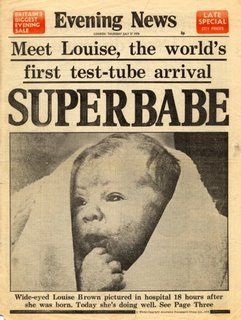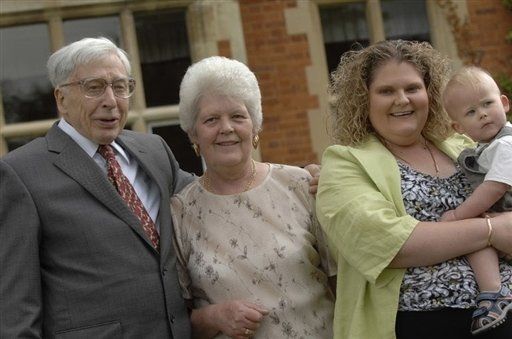Born on the 25th July 1978, Louise Joy Brown was born at the Oldham General Hospital in the United Kingdom. Her parents, Lesley and John Brown had been unsuccessfully trying to conceive for nine years, prevented due to the fact that Lesley had blocked fallopian tubes.
Louise Brown, moments after birth.
As early as the 1930s the possibility had been raised by researchers that fertilisation of embryos could occur outside the human body (in vitro). In the late 1940s experiments were being conducted in the US in women where eggs were collected and exposed to sperm. In 1959 the first mammalian in vitro pregnancys were achieved using rabbits.
However, demand for assisted pregnancy did not really take off until the 1960s. Falling adoption rates occurred due to better social support for single mothers and safer and wider access to abortion services. In 1961 ovum were first collected using laproscopic methods. In 1973 the first pregnancy in occurred, facilitated by the team of Carl Wood and John Leeton in Melbourne Australia. Unfortunately, this resulted in a miscarriage. Then in 1976, a team of researchers headed by Patrick Steptoe and Robert Edwards reported on an embryo transfer which resulted in ectopic pregnancy.
In 1977 Steptoe and Edwards performed another embryo transfer, this time on Lesley Brown. Unlike previously, they transferred the embryo after two and a half days. This time the pregnancy took. Lesley Brown was monitored very closely throughout, with regular ultrasounds and amniocentesis. About a week prior to her due date, Mrs. Brown developed preeclampsia and the decison was made to deliver her baby early. Louise Joy was born on the 25th July 1978 at 1147pm weighing 2.3 kilograms via emergency caeserean section. Although referred to by the UK media as a "test tube baby" she was actually conceived in a petri dish.
Her sister, Natalie, was born four years later and became the world's fortieth IVF baby.
Since then the technology of IVF has improved in leaps and bounds. The discovery of how to control cycles and stimulate ovulation allowed IVF to become widely useful in a clinical setting. Other techniques such as intra-cytoplasic sperm injection (ICSI) means that IVF is now applicable to male infertility as well. For their work, Prof Edwards won the Nobel Prize in biology in 2010. (Dr. Steptoe passed away in 1988 and would have shared the award, unfortunately the Nobel is not awarded post humously).
There are now well over five million children world wide that owe their existence to IVF and related technologies. All due to the bravery of Lesley and John Brown.
Louise Brown, delightfully, is now the mother of a son, Cameron, conceived naturally and born in 2006. Her father John passed away in 2006. Lesley Brown, unfortunately, passed away just a month ago from complications of a gallbladder infection.
Speaking on behalf of Prof Edwards a spokesperson said it best:
"Lesley was a devoted mum and grandmother and through her bravery and determination many millions of women have been given the chance to become mothers. She was a lovely, gentle lady and we will all remember her with deep affection."
Prof Edwards, Lesley Brown, Louise Brown and her son Cameron.



It's amazing the way the new technology was adopted. In four years since the first IVF baby, FORTY other IVF babies were born? Incredible!
ReplyDeleteNew technology...
ReplyDeleteNow the test tube baby treatment is the best treatment for those who are suffering to conceive a baby.
ReplyDelete